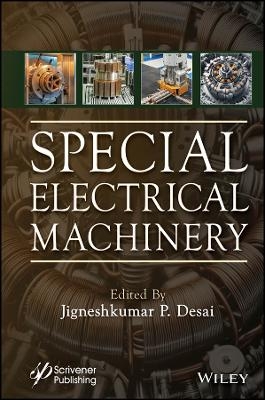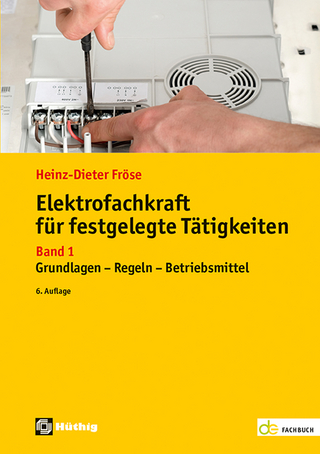
Special Electrical Machinery
Wiley-Scrivener (Verlag)
978-1-394-19361-5 (ISBN)
It covers a range of special machines, including switched reluctance motors, permanent magnet synchronous machines, brushless direct current motor, stepper motors, universal motors, and hysteresis motors. The book also addresses the issue of torque ripple. Much of the literature available today focuses solely on conventional motors and their controls, like induction motors, synchronous motors, PMDC motors, servo machines, and transformers. This book takes a broader view, addressing the growing trend toward specialized motors tailored to specific applications and new innovations in control and modification. It aims to offer comprehensive insights into these special machines by providing detailed information on their operating principles, applications, and controls.
This exciting new volume:
Provides application-based examples of machines not covered in other books on special machines
Provides context for the use of special machines used in electric vehicle technology
Gives examples which are helpful for industry practices
Audience
Undergraduate students, post-graduate students, researchers, and industry professionals who study and use special machines
Jigneshkumar P. Desai, PhD, is an assistant professor at the U.V. Patel College of Engineering, Ganpat University in Mehsana, India. He has 11 years of teaching experience and holds one utility patent and one granted design. In addition, he has published three books and more then 15 research papers, adding a wealth of expertise to the content of this guide.
Preface ix
1 Brushless Direct Current Motor 1
Jitendra G. Jamnani
1.1 Brushless DC (BLDC) Motors 2
1.2 Construction of Brushless DC (BLDC) Motors 2
1.3 Brushless DC Motor Drive System 3
1.4 Position Sensors 5
1.5 Features and Advantages of BLDC Motors 6
1.6 Permanent Magnet Rotor Configuration 7
1.7 Types of BLDC Motors 8
1.7.1 Trapezoidal Type BLDC Motor 8
1.7.1(a) Advantages 9
1.7.1(b) Disadvantages 9
1.7.2 Sinusoidal Type BLDC Motor 9
1.7.2(a) Advantages 9
1.7.2(b) Disadvantages 9
1.8 Square Wave Brushless Motor 10
1.9 Torque/Speed Characteristics of BLDC Motor 12
1.10 Applications of BLDC Motors 13
1.11 Conclusion 13
2 Permanent Magnet Synchronous Motors 15
Mousumi Jana Bala and Chandan Jana
2.1 Fundamentals of Permanent Magnets 16
2.2 Early History of Permanent Magnet 18
2.2.1 Alnico Magnet 19
2.2.2 Ceramic Magnet 19
2.2.3 Rare-Earth Magnet 19
2.3 Direction of Magnetisation 21
2.4 Permanent Magnet Synchronous Motors 23
2.4.1 Merrill’s Rotor 25
2.4.2 Surface Permanent Magnet Motor (SPM) 26
2.4.3 Inset Permanent Magnet Motor 26
2.4.4 Interior Permanent Magnet Motor 26
2.4.5 Buried Permanent Magnet Motor 27
2.5 Comparison of PMSM with Induction Motor 27
2.6 Operating Principle of PMSM 28
2.6.1 Induced EMF 28
2.6.2 Electromagnetic Power 29
2.6.3 Electromagnetic Torque Developed 29
2.6.4 Form Factors 31
2.6.5 Armature Reaction Reactance 32
2.7 Equivalent Circuit 34
2.8 Phasor Diagram 35
2.9 Performance Characteristics 38
2.10 Starting 39
2.10.1 Asynchronous Motor Start 39
2.10.2 Auxiliary Motor Start 40
2.10.3 Variable Frequency Start 41
2.11 Dynamic Modeling of PMSM 41
2.12 Cogging Torque 43
2.12.1 Reasons Affecting Cogging Torque 45
2.12.2 Methods for Reduction of Cogging Torque 46
2.13 Control of PMSM 47
2.13.1 True Synchronous Mode or Open Loop V/f Control Method 48
2.13.2 Self-Control Mode 50
2.13.3 Vector Control 50
2.13.4 Field Weakening Mode 53
2.14 Application of Permanent Magnet Synchronous Motor 54
3 Hysteresis Motor 61
Richa Jain and Sudha Gulati
3.1 Introduction 62
3.2 Construction 64
3.3 Principle of Hysteresis Motor 66
3.4 Classes of Hysteresis Motor 67
3.5 Hysteresis Torque and Hysteresis Loss Equation 68
3.6 Selection of the Appropriate Material for Hysteresis Motor 72
3.7 Models 73
3.7.1 Dynamic Model 74
3.7.2 Finite Element Model 74
3.8 Limitations 75
3.9 Future Prospects 76
4 Switch Reluctance Motor 79
V.B. Babaria and Jigneshkumar P. Desai
4.1 Introduction 79
4.2 Construction of SRM 80
4.3 Operation and Characteristic of SRM 81
4.4 Classification of Rotor Position Sensor 82
4.4.1 Resolver 82
4.4.2 Encoder 82
4.4.3 Hall Effect Sensors 83
4.4.4 Resolvers with Digital Output 83
4.4.5 Optical Encoders 83
4.4.6 Inductive Sensors 83
4.4.7 Rotary Variable Differential Transformer (RVDT) 83
4.4.8 Synchro Resolver 83
4.4.9 Magneto Strictive Sensors 84
4.5 Torque Equation of SRM 85
4.6 Different SRM Converters 89
4.6.1 Two Power Semi-Conductor Switching Devices Per Phase and Two Diodes 89
4.6.2 Merits 90
4.6.3 Demerits 90
4.7 (n+1) Double Switching Devices and (n+1) Diode 90
4.7.1 Merits 91
4.7.2 Demerits 91
4.8 Phase Winding Using Bifilar Wires 92
4.8.1 Merits 92
4.8.2 Demerits 93
4.9 Split Link Circuit Used with Even Phase Number 93
4.9.1 Operation 93
4.9.2 Merits 94
4.9.3 Demerit 95
4.10 Merits and Demerits of SRM 95
4.10.1 Merit 95
4.10.2 Demerits 95
4.11 Applications 96
4.12 Future Scope 96
5 Stepper Motors 99
Ankur P. Desai and Jignesh P. Desai
5.1 Introduction 99
5.2 Constructional Features 99
5.3 Principle of Operation 100
5.4 Torque-Speed Characteristics 102
5.5 Drive Circuits 103
5.6 Types of Steppers Motors 104
5.7 Example: Calculation of Steps per Revolution 105
5.8 Applications 105
5.9 Conclusion 106
6 Universal Motor 107
Jigneshkumar P. Desai
6.1 Introduction 107
6.2 Construction 107
6.3 Principle of Operation 108
6.4 Concentrated-Pole-Non-Compensated Type 109
6.5 Speed Control Methods 109
6.6 Applications 110
7 Torque Pulsation Analysis in PMSM 113
Kannan Selvam, Subhanarayan Sahoo and Kaumil Shah
7.1 Introduction 113
7.2 Construction Based Torque Pulsation 116
7.3 Switching Strategy Based Torque Pulsation 126
7.4 Summary 136
References 137
Index 143
| Erscheinungsdatum | 21.08.2024 |
|---|---|
| Sprache | englisch |
| Gewicht | 567 g |
| Themenwelt | Technik ► Elektrotechnik / Energietechnik |
| Technik ► Maschinenbau | |
| ISBN-10 | 1-394-19361-0 / 1394193610 |
| ISBN-13 | 978-1-394-19361-5 / 9781394193615 |
| Zustand | Neuware |
| Haben Sie eine Frage zum Produkt? |
aus dem Bereich


